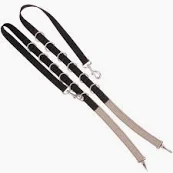Key points about side reins
2024-01-26
Side reins are pieces of training equipment used in horse training to encourage a horse to maintain a specific head carriage and outline while being lunged or worked in hand. They are part of a horse's tack and are attached to the bit or the surcingle (a wide, strap-like piece around the horse's barrel). Side reins can be beneficial for developing the horse's balance, flexibility, and engagement. Here are key points about side reins:
1. Purpose:
- Encouraging Head Carriage: Side reins are designed to encourage the horse to carry its head in a desired position, promoting a rounder frame and engagement of the hindquarters.
- Consistent Contact: They provide a consistent and elastic contact with the bit, encouraging the horse to seek contact and work into the bridle.
2. Components:
- Straps: Side reins typically consist of adjustable straps made of leather or synthetic materials. These straps connect from the bit rings or the surcingle to the girth, creating a triangle shape.
- Elastic Inserts: Some side reins have elastic inserts to allow for a degree of give and flexibility. This helps avoid creating a fixed and rigid connection.
3. Attachment Points:
- Bit Attachment: One end of the side reins attaches to the bit, usually to the bit rings.
- Surcingle Attachment: The other end attaches to the surcingle, which is placed around the horse's barrel. This provides stability and helps maintain the desired outline.
4. Adjustability:
- Length Adjustment: Side reins are adjustable in length to accommodate horses of different sizes and conform to various training objectives.
- Balanced Tension: Proper adjustment ensures that the tension is balanced on both sides, allowing the horse to work symmetrically.
5. Types:
- Fixed Side Reins: These have a fixed length and provide a consistent level of contact. They are commonly used for horses that are already well-trained.
- Elastic Side Reins: These have elastic inserts that allow for some give and take. They are often used for horses in training or those needing more flexibility.
6. Training Stages:
- Introduction: Side reins are typically introduced gradually to allow the horse to become accustomed to the feel of contact. Initial sessions may involve ground work and lunging at a walk.
- Progression: As the horse becomes more accustomed, side reins can be used in a variety of gaits to encourage proper carriage and engagement.
7. Training Goals:
- Engagement: Side reins help the horse engage its hindquarters and work over its back.
- Balance: They contribute to the development of balance, flexibility, and a rounded frame.
- Muscle Development: Proper use of side reins can aid in the development of specific muscle groups.
8. Caution and Supervision:
- Proper Supervision: Side reins should be used under the supervision of an experienced trainer or rider who understands their proper application.
- Regular Monitoring: Handlers should regularly check the fit and condition of side reins to ensure they are safe and effective.
It's important to use side reins judiciously and as part of a comprehensive training program. They should be incorporated with an understanding of the horse's individual needs and physical condition. Correct use of side reins can contribute to the horse's development and training, but misuse can lead to discomfort and resistance.



